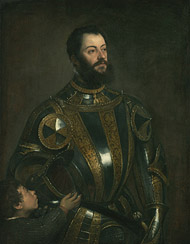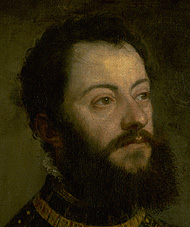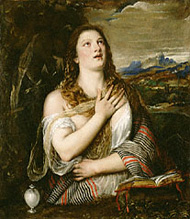|
This focused exhibition highlights the Getty's recently acquired Portrait of Alfonso d'Avalos, Marquis of Vasto, in Armor with a Page by Titian, presenting it alongside two other paintings d'Avalos commissioned from Titian.
The Artist
Tiziano Vecellio, called Titian (about 1487–1576), was the finest portrait painter of the Renaissance. The artist flattered his sitters and gave them dignified poses, adding just a few accessories to define their personalities. His clients included popes, kings, diplomats, lawyers, intellectuals, and military men such as Alfonso d'Avalos.
The Patron
Alfonso d'Avalos was a military commander for Holy Roman Emperor Charles V and the personification of a Renaissance courtier—educated, literate, creative, elegant, and social. He collected art, wrote poetry and prose, and even appeared as the military savior of the Italian peninsula in a 16th-century epic poem.
|
|
The Getty Portrait
D'Avalos commissioned the portrait shown above from Titian in early 1533, when he was captain general of the imperial infantry in Italy.
Titian presented d'Avalos preparing for battle mentally and physically. Lost in thought, d'Avalos is almost oblivious to the page presenting him with his helmet (see detail).
His expressive face (left) and the position of his hand on his sword suggest a combination of thought and action, while his gleaming armor (see detail) indicates his high status.
|
 |

 |
 |
The Allocution of Alfonso d'Avalos, Marquis of Vasto, to His Troops, Titian (Tiziano Vecellio), 1540–1541
Photographic Archive. Museo Nacional del Prado, Madrid
|
 |
 |
|
The Prado Portrait
D'Avalos commissioned this portrait in late 1539, when he was governor of Milan and commander of Charles V's imperial troops in Italy. It combines a full-length portrait with a history painting on a monumental scale.
Titian depicted d'Avalos addressing his troops on a platform, with his son as the page.
The painting advertised d'Avalos's loyalty to Charles V by evoking an incident that had occurred two years before, when the marquis persuaded the emperor's troops in Lombardy not to revolt despite a lack of food and pay.
The portrait is on loan from the Museo Nacional del Prado, Madrid.
|
|
Mary Magdalene
Titian was renowned for his sensuous, devout portrayal of Mary Magdalene. He produced many variations of this popular image for collectors and royal clients across Europe.
In 1531 d'Avalos ordered a painting of the Magdalene from Titian to give to his cousin Vittoria Colonna, who was devoted to the saint.
This painting, made between 1555 and 1565, is probably a variation on the painting d'Avalos had ordered from Titian.
D'Avalos was an important patron of the visual arts, acquiring paintings by Titian and other Renaissance artists beyond the three shown here. Sadly, his life was cut short at the age of 44.
The exhibition is located at the Getty Center, Museum, North Pavilion.
|



